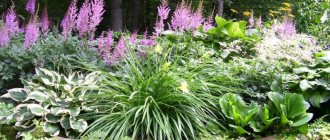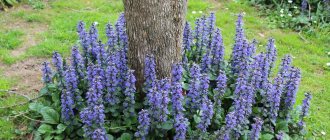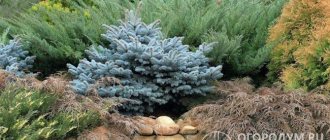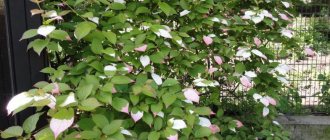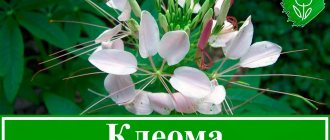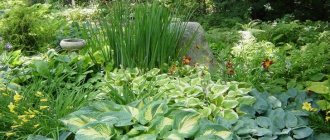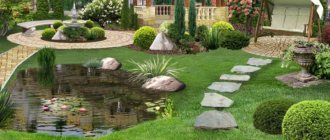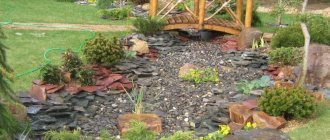Even in dense shade you can create a bright and lush plant carpet
The shade under small-leaved trees (birch, willow, aspen, alder) is not as dense as under broad-leaved trees (oak, linden, maple), where it is light only before the leaves bloom. At the same time, the soil under birch, willow and maple trees is very dry.
Under light coniferous species (pine, larch) it is drier and lighter than under dark coniferous species (spruce, fir). But even under the fir trees on the south side, some perennials will grow. But from the north and between the trees, where there is impenetrable shadow, it is unlikely that anything will take root.
Important : remember that litter under coniferous trees acidifies the soil, so you will either have to remove it regularly in order to grow the usual perennials.
We invite you to meet ten “Spartans” who will survive even in dry and shady places.
Ads by
Tiarella cordifolia
Immediately after the snow melts, the garden is decorated with wintering leaves of Tiarella cordifolia with pinkish-bronze veins.
After flowering, the plant produces tendrils with daughter rosettes: they take root and form a green carpet. Heart-leaved tiarella (Tiarella cordifolia) To learn how to distinguish tiarella from heucherella, read the article Heucherella - the tamed shrew.
Herbaceous shade-loving perennial plants
There are many different types and varieties of herbaceous plants. For example, the most common are forest geraniums, lilies of the valley, brunnera, aquilegia, volzhanka, tiarella, pachysandra, columbine, dicentra, ferns, etc. Plant them evenly on the site and after about 3 years they will close together and look presentable.
Red Horny Goat Weed
Red mountain weed (Epimedium rubrum) forms a dense, neat carpet right around tree trunks.
Young leaves look very bright, and in May, reddish flowers of unusual shape add color. Red mountain weed (Epimedium rubrum) You will find more information about mountain weeds in the publication What attracts us to mountain weeds: a portrait of a shade-loving plant.
What to remember when planting plants in the shade
When choosing shade-loving plants, you should remember that it will also need certain things in the same way as light-loving ones. Plants in the shade will not survive in your garden unless you keep an eye on them.
How to choose
You should choose shade-loving plants not only according to the place where you plan to plant it, but also according to your own strength. Some plants may go wild and your participation in its life may no longer be needed, while others will not bloom or even die from your little mistake. Choose a location responsibly and find out for sure what kind of shade there is.
Care Tips
Shade-tolerant plants also require watering, fertilizing, pruning and prevention against pests and diseases. Make a schedule for caring for the plant, so you will understand what the plant needs and in what quantity. Find out which plants should not have a neighbor and what distance should be between the two species.
Important nuances
Some nuances when working with shade-loving plants include the density of the shadow that covers the growing area. You cannot plant a plant that needs diffuse shade in a place that is covered in deep, dense shade, and vice versa.
Flower beds
Even in a shady place you can arrange a flower garden. The more shaded space, the more beautiful your flower garden will be. You can combine hydrangea with iris, and anemones can accompany fragrant violet, but everything is at your discretion.
From periwinkle seedlings you can lay a beautiful soft blue carpet over your area. By planting lily of the valley, from the first days of spring your garden will be filled with a charming aroma.
Rock garden
Why not decorate your garden in Asian style? Turn your yard into a rock garden.
Create original compositions from stones and plants that grow in your garden. Believe me, creating a rock garden is not difficult, but it will seem like designers worked on it because it looks professional.
Relaxation area and decorative elements
The recreation area should always occupy a comfortable location on the site. In the summer, a seating area in a shaded place to hide from the scorching sun is what you need.
You can add garden chairs, loungers or even a swing. You can use shrubs, trees, grass or stones to decorate the recreation area.
Design of tree trunk circles
Tree trunk circles should also not go unnoticed. For decoration, you can use shade-loving turf or ground cover plants, sawdust or herbaceous plants.
The tree trunk does not have to be round, so don’t be afraid to experiment.
Kochedyzhnik
Scalloping ferns (Athyrium), forest ferns with lacy leaves and thick rhizomes, thrive in dry shade under trees.
The most commonly grown plants are female (Athyrium filix-femina) and nippon (Athyrium niponicum), which are spectacular already in the spring, when the fronds are just unfolding. Nippon nomadic fern (Athyrium niponicum) We have already written about nomadic ferns and other ferns in the articles:
- Fan leaves: types of ferns and their features
- Perennials with beautiful leaves: where to plant them and how to care for them
Shade-loving shrubs
The choice of varieties is quite large, so many gardeners, and especially beginners, are simply lost in the variety of types of shrubs.
To make it easier for you to understand such a difficult issue, we have prepared a TOP 10 list along with photos of shade-loving shrubs that are perfect for a country house.
Canadian hemlock
It is a coniferous tree, the peculiarity of which is its slow growth. The maximum height of hemlock reaches 7 meters. Outwardly, it is also weeping, like willow. Usually takes the shape of a wide pyramid.
Separately, it is worth highlighting the needles, which have a rich dark green color and small increments of light green color. Hemlock is an excellent solution if you want to create a small undergrowth or cover an unsightly fence on the north side of the house.
The most popular varieties are “Gentsh White” with white stripes and “Golden King” in gold color.
Cross-paired microbiota
Another coniferous plant for growing in the shade of a garden plot is cross-paired microbiota, which looks very similar to a green small pond. Its width already at 10 years is approximately two meters. She is not at all afraid of even strong winds and bad weather; moreover, she is able to withstand severe frosts down to -40 degrees.
Due to its decorative appearance, it is very popular among many summer residents. Flowers are often planted against its background, because thick needles and bright green colors only add spectacularity and attractiveness to flowering plants.
Yew berry
Next on the list is a coniferous dioecious and slow-growing plant. Upon reaching 30 years of age, its height can reach 3.5 meters. It is distinguished by the dark color of its needles, which is why many gardeners choose this particular species, because this way you can create contrast and more interesting compositions.
It is also impossible not to note the fruits of the yew itself - these are bright red berries. The truth is, you can’t eat them. Imagine how beautiful your plot will be in the form of bright small fruits against a background of emerald-colored needles. For this reason, yew berry is often used by landscape designers.
Euonymus winged
Here is a deciduous and slow-growing plant of shade-loving shrubs. The maximum diameter is two meters. Winged euonymus allows you to create small figures, for example, a small umbrella, a ball or a more complex composition in the form of a bonsai. It lends itself well to cutting and its small leaves add nobility, which is why it is popular among landscape designers.
The beauty of the plant is especially revealed in the fall, when the leaves on the trees have already lost their color. At this moment, the euonymus changes its color to a pronounced crimson color. If you look at it from afar, it looks like a flower is blooming.
Derain
Another common type of shrub that grows up to 4 m in diameter. The main advantage of the plant is that you can control its size yourself; you just need to trim it regularly.
The leaves of the tree are distinguished by an unusual white-green color. It is completely unpretentious and is not afraid of frost, strong winds or bad weather. With its appearance, the shrub creates the illusion of an ever-blooming tree. As for care, it is enough to sometimes feed and trim.
Please note that derain loves moderately to very moist soil, so it will have to be watered abundantly. Do not forget that this shrub mainly grows near bodies of water. Answering the question of how to water a plant, we note that you should not overdo it; it is enough that the soil is moist.
Rowan or viburnum
Both trees have few differences from each other, which is why they can be placed on the same line in the rating. The two of them look presentable thanks to their red fruits and are absolutely undemanding in care.
Healthy! If the area on which the shadow falls is illuminated for more than five hours a day, then you can plant an interesting variety, and not just limit yourself to ordinary mountain ash. The most popular varieties include: Titan, Garnet, Scarlet large, etc.
But another variety of viburnum will not be able to grow in the shade; only “Sargenta” will cope with this task.
Syringa
Jasmine or mock orange can reach four meters in height and about the same in width. It is easy to cut, which means it can be easily given the desired shape. The main thing is to do this procedure after flowering for two weeks, otherwise the bush will simply lay flower buds.
One of the advantages of a shade-loving plant is that almost all varieties are perfect for an area in the shade. More experienced gardeners recommend double and strawberry jasmine.
Mahonia holly
Mahonia cannot boast of fast growth or great height, because it reaches a maximum of 1.2 m. Its main advantage lies in its shiny leaves with spines, which in the fall take on a pronounced reddish-cherry hue, attracting the eyes of passers-by.
Mahonia holly produces edible fruits that are blue in color and rich in beneficial vitamins. By the way, this is one of the few deciduous shrubs that feel great in the conditions of the Moscow region.
Important! If you want Mahonia to bear fruit, then purchase at least two seedlings.
Rhododendrons
Gardeners call this plant a real spring king, because the bush itself consists entirely of bell-shaped flowers. In spring, when the flowering period begins, it seems as if there is a whole bouquet in front of you.
They have one feature that must be taken into account when planting: they only need acidic soil. To do this, you will have to resort to one of two options: use a special mixture intended for the heather family, or stock up on acidic peat.
A year after the first planting of rhododendrons in the ground, it is necessary to take care of fertilizers. Also, these plants will need to be covered under a frame shelter that will protect them from wet snow.
Hydrangea paniculata
This list is completed by a flowering shrub, which shows its beauty in the second part of summer, when lilac, jasmine, viburnum and many other plants have already bloomed. Hydrangea is rich in varieties, especially since they are still bred today.
They are not at all afraid of the local climate, but they have one interesting feature. They bloom later than other plants.
Lily of the valley
This is an unpretentious crop with a creeping rhizome. Lily of the valley feels great in slightly moist soil and in slight shade. In dense shade the plant survives, but blooms weakly. Lily of the valley is frost-resistant.
At the end of the season, the bed can be mulched with a thick layer of natural materials.
It is advisable to loosen the soil more often. The flower looks amazing under the canopy of fruit or coniferous trees and shrubs.
Does it make sense to consider the option of planting fruit-bearing shrubs in shaded areas?
Yes, some fruit-bearing shrubs can be grown in shaded conditions. Let's look at the descriptions of the most unpretentious plants.
Honeysuckle
This fruit-bearing shrub owes its popularity to its hardiness; it can develop normally in shaded areas, it is not demanding on soil quality, and is resistant to polluted air, which allows it to be grown in urban environments.
Today, many varieties of honeysuckle have been bred, so the shrub can have quite large differences in the color of leaves and flowers, and the fruits can also differ in shape and ripening time.
It should be remembered that some varieties of honeysuckle, for example, Honeysuckle, are suitable for growing in good light, while others (Tatarskaya) can withstand moderate shading well.
Honeysuckle is used for single plantings, vertical gardening, and for arranging hedges.
Barberry
The plant is characterized by rapid growth and high resistance to frost. The bushes do not require special care; the plant can withstand even severe droughts.
The leaves of barberry are small, beautifully shaped, green in summer, and by autumn they change color to burgundy.
The Thunberga barberry variety has burgundy leaf color throughout the summer, and the Thunberga Goldalita barberry has golden yellow leaves.
Barberry berries have a pleasant aroma and excellent taste; they are used in cooking, especially in oriental recipes.
Gooseberry
It can be grown in sunny or shaded areas. The plant does not need frequent watering; it easily tolerates short droughts.
During the ripening process, gooseberries acquire a yellow or reddish tint and become translucent.
The fruits are used in cooking; compotes and jam are made from them.
Elecampane magnificent
This rather tall plant has a straight stem with large leaves. Elecampane is considered a relative of the aster. The petals of a flower remind us of this. Elecampane magnificent can be planted in places with light shade.
The soil should be enriched with organic fertilizers. The plant tolerates drought normally. The soil next to the plantings can be mulched to reduce moisture evaporation.
